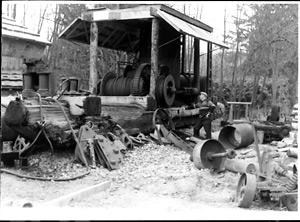Powell River Historical Museum and Archives wants to return a long-lost sawmill to its rightful home.
During City of Powell River Council’s Thursday, October 16, committee of the whole meeting, Bert Finnamore, the museum’s heritage manager, said he wanted to apprise the committee about the potential acquisition of the Anderson sawmill collection offered by Burnaby Village Museum. Acquiring this collection, that originally came from this area, would be a large opportunity, but to proceed, the museum would require permission to site the collection.
Finnamore said Andy Anderson, a long-time resident of this community, owned the logging equipment. He was born in Sweden in the late 1800s, immigrated to the United States and moved to British Columbia in 1901. In 1908 he came to Powell River looking for work.
Anderson worked at a variety of jobs and in 1932 started his sawmill on Powell Lake. The sawmill operated at that site until 1960, until the lease he had was terminated. The sawmill was then moved to Mowat Bay. Anderson operated at a 16-acre site and he continued for a number of years.
In 1976, the city purchased the land but not the equipment. Powell River’s museum at the time expressed an interest in obtaining the equipment but was unable to do so because of lack of room and funds.
The same year, the Burnaby museum, recognizing its historical significance, purchased the collection “lock, stock and barrel.”
“This equipment dates back to the 1870s,” Finnamore said. “Most of it is from between 1900 and 1920. The Burnaby museum called us last spring and asked if we were interested in obtaining it.”
Finnamore said the museum approached a couple of people with expertise in these types of mills and took them down to Burnaby Village to check the collection.
He said the equipment is in fairly decent condition but some of it has been rusting for more than 15 years. Finnamore believes the equipment could be brought back to operating shape, although that would not be in the plans.
He said the Burnaby museum no longer wants the equipment because the level of logging that would have required such a mill never occurred in the Vancouver area, which was hand-logged. The Powell River museum was given first right of refusal to procure it.
“We consider it worth acquiring,” Finnamore said. “We believe we can raise the funds and partnerships to get the stuff here. We have no intention to operate it but we think it would be a very good addition to the historical collection in town. What we want to do, before we say yes to this, is know we have somewhere to put it.”
Finnamore said the chosen spot is above the current forestry museum site in the old Willingdon Beach bathhouse, on a flat spot just below the highway. He said he has spoken to city staff about potential conflicts and none are apparent.
“My question to council is, can we site it there?”
Mac Fraser, the city’s chief administrative officer, asked committee members if they wanted city staff to produce a report for the next city council meeting to determine potential municipal involvement in the project, and then approval in principal for siting the artifacts.
The committee directed staff to prepare the report. Finnamore said the Burnaby museum will need to know by early next year whether the Powell River museum wants the artifacts, which have been offered to the local group for free. The museum’s challenge will be to transport and set up the equipment. Finnamore said the museum was not approaching the city for funding.



